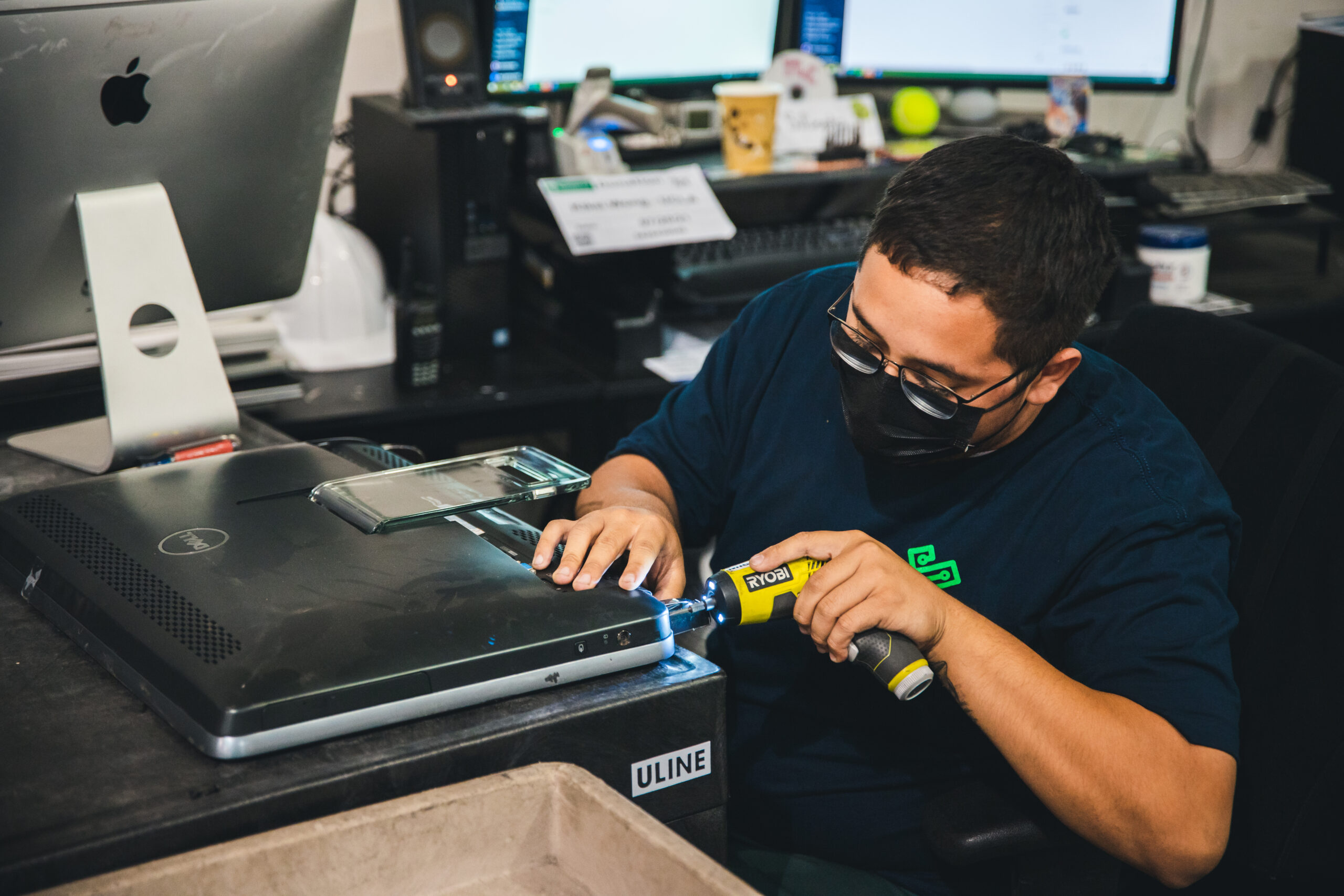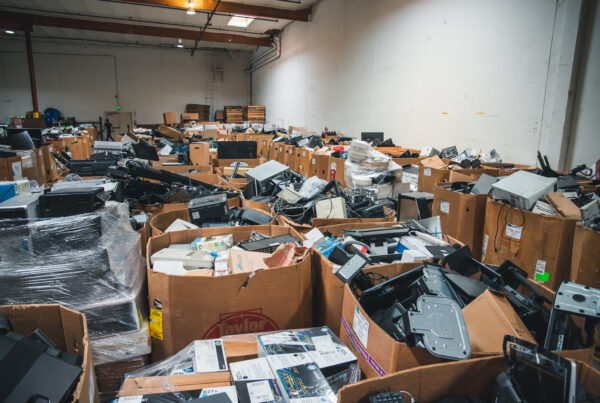Last Updated: October 2025
Editor’s Note: This article was originally published in 2023 and updated in October 2025 to reflect the latest Right to Repair legislation victories, current e-waste statistics, and emerging challenges like parts pairing. We’ve also expanded our guidance on how you can take action today.
We find ourselves surrounded by electronics. Smartphones, laptops, tablets—these devices enhance our lives. But they come with a hidden cost. As they break or become outdated, they fuel a growing global crisis: electronic waste.
Besides tech filling up landfills, e-waste is about valuable resources being wasted. It’s about toxic materials poisoning our environment. And it’s about missed opportunities to extend the life of perfectly functional technology.
Enter the Right to Repair movement — a powerful solution to the e-waste problem. This initiative champions the simple idea that we should be able to fix the products we own. Extend their lifespan. Reduce the need for constant replacements.
The path forward isn’t easy. Industry opposition, legislative hurdles, and new technological barriers stand in the way. But with every challenge comes opportunity. An opportunity for change, innovation, and a more sustainable future.
Table of Contents
- Understanding the E-Waste Crisis
- What Is the Right to Repair Movement?
- How Repairability Reduces E-Waste
- The Fight Against Planned Obsolescence
- Right to Repair Wins 2023-2024
- Challenges That Remain
- How Human-I-T Supports Repair and Reuse
- What You Can Do to Reduce E-Waste
Understanding the E-Waste Crisis
Global E-Waste by the Numbers
According to The Global E-waste Monitor 2024, the world generated a record 62 million metric tons of e-waste in 2022—an 82% increase from 2010.
The future trajectory is even more alarming. UNITAR projects e-waste will reach 82 million metric tons by 2030, a 32% jump from 2022 levels. E-waste is rising five times faster than documented recycling efforts.
On top of that, only 22.3% of that e-waste was properly collected and recycled in 2022. The rest? Burned, dumped in landfills, or processed through informal channels that harm both people and the planet.
The economic loss is staggering. The Global E-waste Monitor reports that improper e-waste management cost the global economy $37 billion in 2022. Meanwhile, $91 billion in valuable materials—including copper, gold, and rare earth elements—are lost annually because we’re not recycling effectively.
Why the United States Leads in E-Waste Generation
The United States plays an outsized role in this crisis. Americans generate some of the highest per-capita e-waste rates globally. Our consumption habits, short product life cycles, and limited repair infrastructure all contribute to the problem.
The issue is environmental and personal. Every broken laptop that gets tossed and every smartphone replaced because a cracked screen seemed impossible to fix. These decisions add up. They drain wallets and damage entire ecosystems.
What Is the Right to Repair Movement?
The Origins: From Conflict to Advocacy
The Right to Repair movement emerged from frustration. In July 2013, independent repair shops found themselves increasingly blocked as manufacturers stopped providing parts, tools, and even access to device firmware. What started as a practical problem evolved into a full-scale advocacy effort.
The Repair Association formed to unite independent repair providers, environmental activists, and consumers. Their mission? Fight for legislation that gives people the tools, parts, and information they need to fix their own devices.
The movement centers on three fundamental rights:
- Access to parts. Manufacturers should sell replacement components to anyone who wants to fix a device—not just authorized repair centers.
- Access to tools. Specialized equipment needed for repairs shouldn’t be locked behind corporate walls.
- Access to information. Repair manuals, diagnostic software, and technical documentation should be freely available.
These demands are hardly revolutionary or progressive. But they are about restoring something we used to take for granted: the ability to fix what we own.
How Repairability Reduces E-Waste
Extending Device Lifespan Saves Resources
Repairability directly attacks the root cause of e-waste: premature disposal. When devices can be repaired, they last longer. Longer-lasting devices mean fewer new products manufactured. Fewer products manufactured means less resource extraction, less energy consumption, and less waste.
The math is simple but powerful. According to The Repair Association, American households could save an average of $330 annually by repairing phones, computers, and appliances instead of replacing them.
The Economic Case: Repair vs. Replace
A cracked iPhone screen repair at an independent shop? Around $100-150. A new iPhone? $800-1,200. That’s money staying in your pocket and a functional device staying out of the landfill.
The US Public Interest Research Group found that consumers could collectively save billions by choosing repair over replacement. These savings matter most for low-income families who can’t afford to constantly upgrade.
Success Story: Patagonia’s Repair-First Model
Some companies already get it. Patagonia built their entire business model around repairability. Their Ironclad Guarantee covers repairs for any damage. They provide free DIY repair tutorials. They advocate for Right to Repair legislation.
The result? Products that last decades instead of years. Customers who become brand loyalists. A business model that’s both profitable and sustainable.
Patagonia proves that repairability is definitely good for the environment — and for business.
The Fight Against Planned Obsolescence
How Manufacturers Design for Disposal
Many companies design products to fail. Or at least, they design them to become obsolete quickly.
Planned obsolescence takes many forms. Batteries glued into place. Components soldered together. Software updates that slow down older devices. Designs that make simple repairs impossibly complex.
The shift from modular, repairable products to sealed, disposable units happened gradually. But the impact has been massive. Consumers now expect to replace rather than repair. The throwaway culture has become normalized.
The Real Cost of “Throwaway Culture”
This disposable mindset has consequences. Electronic devices contain hazardous materials — lead, mercury, cadmium. When these devices end up in landfills, these toxins leach into soil and water.
E-waste makes up only 2% of landfill mass but accounts for 70% of toxic waste. That’s a disproportionate environmental impact we can’t ignore.
Manufacturing new devices also requires immense resources. Mining rare earth elements. Shipping materials globally. Energy-intensive production processes. Every premature replacement multiplies this environmental toll.
Right to Repair Wins 2023-2024
State-Level Legislative Victories
The tide is turning. Between 2022 and 2024, Right to Repair scored major victories across the United States.
New York led the way. The state’s Digital Fair Repair Act took effect in December 2023, becoming the first state-level electronics Right to Repair law in the nation.
California followed with its Right to Repair Act (SB 244), signed by Governor Gavin Newsom in October 2023 and effective July 1, 2024. The law covers electronics and appliances sold for $50 or more, requiring manufacturers to provide parts, tools, and documentation for at least three to seven years after production.
Minnesota passed its Digital Fair Repair Act, also effective July 1, 2024. The law applies broadly to digital electronic equipment sold or used after July 1, 2021.
Oregon made history in March 2024. Governor Tina Kotek signed a Right to Repair bill that became the first in the nation to explicitly ban “parts pairing”—the practice of using software to prevent technicians from installing replacement parts. The law takes effect January 1, 2025.
Colorado continued its leadership with HB 1121, signed May 28, 2024. The Consumer Right to Repair Digital Electronic Equipment bill takes effect January 1, 2026.
According to iFixit, Right to Repair bills have now been introduced in all 50 US states. Five states have passed comprehensive electronics legislation. One in five Americans now lives in a state with Right to Repair protections.
And, while details vary, these laws share common requirements:
- Manufacturers must provide parts, tools, and documentation to independent repair providers and consumers on “fair and reasonable” terms.
- Parts and information must remain available for several years after a product stops being manufactured (typically 3-7 years depending on price).
- Manufacturers cannot use contractual clauses or technical measures that obstruct repairs.
- State attorneys generally have enforcement authority, with penalties ranging from $1,000 to $5,000 per violation per day.
Challenges That Remain
Parts Pairing: The New Barrier to Repair
Just as Right to Repair gains momentum, manufacturers have found new ways to block repairs. The biggest threat? Parts pairing.
Parts pairing is a practice where manufacturers use software to “marry” components to specific devices. Replace a screen or battery with a genuine part from another identical device, and features stop working. Warning messages appear. Functions get disabled.
iFixit calls parts pairing “the biggest threat to repair.” In January 2024, they tested this on iPhones. Swapping a battery from one iPhone to another — both genuine Apple products — triggered error messages claiming the battery wasn’t genuine.
Apple’s response has been mixed. In April 2024, the company announced changes allowing used genuine parts in iPhone 15 and newer models. They introduced a “Repair Assistant” tool with iOS 18 to enable on-device parts calibration.
But iFixit’s testing in October 2024 found the implementation “promising but flawed.” Features like Face ID still wouldn’t calibrate properly. Activation-locked parts remained unusable. Third-party parts continued to face restrictions.
As Fight to Repair notes, “The practical consequences of that could be devastating for small, independent repairers.”
Industry Opposition Continues
Manufacturers argue parts pairing protects security and safety. They claim opening up repairs could compromise user privacy or create safety risks.
But consumer advocates push back. They argue these concerns are overblown — excuses to maintain repair monopolies and force consumers to buy new devices.
The Security Industry Association has raised concerns about Right to Repair’s impact on alarm systems and life safety equipment. Some industries have legitimate security considerations.
But for most consumer electronics? The security argument doesn’t hold up. After all, Patagonia manages to offer repairs without compromising product integrity.
Even laws on the books have weaknesses. Many include broad exemptions for:
- Game consoles
- Medical devices
- Commercial security equipment
- Vehicles (in some states)
These carve-outs, while sometimes justified, create gaps that leave millions of devices outside Right to Repair protections.
How Human-I-T Supports Repair and Reuse
Our Refurbishment Process
At Human-I-T, we live the Right to Repair philosophy every day. Since 2012, we’ve transformed end-of-life technology into opportunities. Our comprehensive refurbishment process extends device lifespans and keeps e-waste out of landfills.
Here’s how we do it:
- Collection. We partner with businesses to collect their outdated technology. Rather than sending functional equipment to recyclers who break it down for raw materials, we give devices a second life.
- Assessment. Our technicians evaluate every device. Can it be refurbished? Does it meet quality standards? We’re selective—only devices that can provide reliable service move forward.
- Refurbishment. We repair, upgrade, and thoroughly test each device. New operating systems. Performance checks. Quality assurance. Every refurbished laptop, tablet, or desktop meets strict standards.
- Distribution. Refurbished devices go to people who need them most through our online store and community partnerships. Affordable technology for families. Digital inclusion for underserved communities. Sustainability in action.
We’ve distributed 434,000+ devices, diverted 15.1 million pounds of e-waste from landfills, and provided digital literacy training to 11,500+ learners.
E-Waste Removal That Prevents Dumping
Not every device can be refurbished. Some are too damaged. Others are truly obsolete. That’s where our e-waste removal service comes in.
We provide secure, compliant disposal for businesses and individuals. NAID AAA certified data destruction. R2 certification. ISO standards compliance. Your data stays protected while devices are responsibly recycled.
What can’t be refurbished gets harvested for valuable components. Materials get recycled through certified partners. Nothing goes to landfills unnecessarily.
Creating a Circular Technology Economy
Human-I-T operates on a circular model that mirrors Right to Repair principles. We extend product lifespans through refurbishment. We make technology affordable and accessible. We handle end-of-life disposal responsibly.
This approach addresses both the e-waste crisis and the digital divide simultaneously. Corporate technology waste becomes someone’s opportunity to get online. Environmental sustainability meets social equity.
What You Can Do to Reduce E-Waste
Support Right to Repair Legislation
Your voice matters. Here’s how to make it heard:
- Contact your state legislators. Find out if Right to Repair bills are pending in your state. Call or email your representatives. Tell them you support repair rights.
- Sign petitions. The Repair Association and PIRG regularly organize campaigns. Add your name.
- Share your repair story. Personal experiences resonate with lawmakers. Have you struggled to get a device repaired? Been forced to replace something that should have been fixable? Share it.
Choose Repair Over Replacement
- Before buying new, explore repair options. Local repair shops can often fix devices for a fraction of replacement cost.
- Learn basic troubleshooting. Many “broken” devices just need simple fixes. YouTube tutorials, iFixit guides, and manufacturer resources can walk you through common repairs.
- Consider repairability before buying. iFixit publishes repairability scores for popular devices. Choose products designed to be fixed.
Buy Refurbished When Possible
Refurbished doesn’t mean inferior. It means tested, warrantied, and significantly cheaper than new.
- Shop Human-I-T’s online store. We offer refurbished laptops starting at $130. Brand names like HP, Dell, and Apple. Income-qualified discounts available through our free Gold Membership.
- Look for certified refurbishers. Whether it’s Human-I-T or another reputable organization, certified refurbishers guarantee quality.
- Save money and the planet. Buying refurbished reduces demand for new manufacturing while giving you reliable technology at accessible prices.
Responsibly Recycle End-of-Life Devices
When a device truly reaches the end of its useful life:
Wipe your data first. Even with certified recyclers, protect yourself by removing personal information before disposal.
Don’t throw it in the trash. E-waste contains toxic materials that don’t belong in landfills.
Use certified recyclers. Donate your old technology to Human-I-T. We’ll ensure proper data destruction and responsible recycling.






